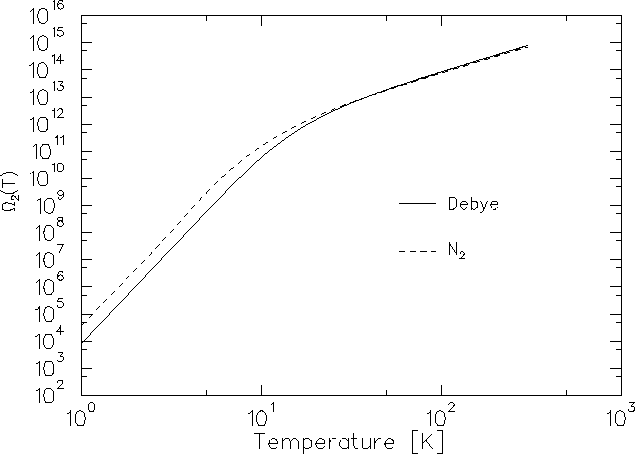 |
 |
At low temperatures (![]() = 83.5 K),
theory predicts that
= 83.5 K),
theory predicts that ![]() should be
proportional to T7. This should hold up to
temperatures of about 10 K, where the temperature dependence
should drop off gradually to a T2 dependence for
should be
proportional to T7. This should hold up to
temperatures of about 10 K, where the temperature dependence
should drop off gradually to a T2 dependence for ![]() and greater.
(The high temperature regime is mentioned here only to exemplify
the T2 behavior; s-N2melts at 63 K).
and greater.
(The high temperature regime is mentioned here only to exemplify
the T2 behavior; s-N2melts at 63 K).
It is not necessary that ![]() itself be
temperature-dependent for there to be a cross-over from
the low-temperature, defect-dominated behavior
to the higher temperature, homogeneous regime.
Since
itself be
temperature-dependent for there to be a cross-over from
the low-temperature, defect-dominated behavior
to the higher temperature, homogeneous regime.
Since ![]() is always a monotonically increasing
function of T, it may be that
is always a monotonically increasing
function of T, it may be that
![]() simply becomes negligible and the hopping behavior
changes from Eq. (6.10) to Eq. (6.9)
at a temperature near 20 K.
At sufficiently low
temperatures
simply becomes negligible and the hopping behavior
changes from Eq. (6.10) to Eq. (6.9)
at a temperature near 20 K.
At sufficiently low
temperatures ![]() will inevitably drop below
will inevitably drop below ![]() and
the behavior we expect in the limit of
and
the behavior we expect in the limit of ![]() ,
as long as the damping rate is sufficient that we still
have incoherent tunnelling, will
always be a hop rate
,
as long as the damping rate is sufficient that we still
have incoherent tunnelling, will
always be a hop rate ![]() .However, there is reason to believe that
.However, there is reason to believe that ![]() may
be temperature dependent in s-N2.
It is known that the
may
be temperature dependent in s-N2.
It is known that the ![]() -N2lattice
undergoes a transition at about 22 K, below which the molecules
take on preferred orientations, rotating at a fixed angle
about the diagonals of the cubic unit cell.
Above this temperature they are free rotators, and the muonium
atom should see the same averaged potential well at each site.
The orientational disorder introduced by this transition
may be responsible for creating level shifts that hinder
tunnelling according to Eq. (6.10).
-N2lattice
undergoes a transition at about 22 K, below which the molecules
take on preferred orientations, rotating at a fixed angle
about the diagonals of the cubic unit cell.
Above this temperature they are free rotators, and the muonium
atom should see the same averaged potential well at each site.
The orientational disorder introduced by this transition
may be responsible for creating level shifts that hinder
tunnelling according to Eq. (6.10).
Impurities in the sample evidently do not affect the muonium
diffusion rate at low temperatures. Experiments were performed
on samples of s-N2with CO concentrations
of 0.01% and 0.1%. Carbon monoxide has the same
molecular mass as N2and freezes in the lattice as a
random substitutional impurity. The results are shown in
Fig. 6.25 along with the results
from the most carefully annealed sample of solid
ultra high purity N2.
At temperatures where muonium diffuses rapidly (between
20 and 30 K) the TF relaxation
rate 1/T2 increases with CO concentration, up to
40 ![]() s-1 with 0.1% CO, well above the rate measured
for nearly static muonium in pure N2at low temperatures.
This is due to muonium diffusing to the CO where it
undergoes a fast chemical reaction to form a diamagnetic species,
so the relaxation rate measures the time-of-flight of the muonium
to the site of the CO molecule.
However, at low temperatures the relaxation
rates are independent of impurity concentration.
Thus the static shift
s-1 with 0.1% CO, well above the rate measured
for nearly static muonium in pure N2at low temperatures.
This is due to muonium diffusing to the CO where it
undergoes a fast chemical reaction to form a diamagnetic species,
so the relaxation rate measures the time-of-flight of the muonium
to the site of the CO molecule.
However, at low temperatures the relaxation
rates are independent of impurity concentration.
Thus the static shift ![]() that seems to become important
at low temperatures is not due to impurites, at least at this level;
its origin seems to be intrinsic to s-N2.
that seems to become important
at low temperatures is not due to impurites, at least at this level;
its origin seems to be intrinsic to s-N2.
 |
The very strong temperature dependence predicted by the
two-phonon model is convincingly demonstrated
in the case of muonium diffusion in solid ![]() -N2below 15 K.
At higher temperatures, particularly 30-50 K, theory
predicts a much weaker dependence than was measured,
as was the case for KCl,
so we cannot claim to fully understand
muonium diffusion quantitatively in this temperature range.
However, the rapid increase
in hop rate as temperature decreases is still strong
qualitative evidence that the muonium is diffusing by
incoherent quantum tunnelling mediated by phonon scattering.
It is possible that this
quantitative failure of the model results from the
breakdown of our (rather simple) assumptions regarding
the frequency dependence of the coupling constants.
-N2below 15 K.
At higher temperatures, particularly 30-50 K, theory
predicts a much weaker dependence than was measured,
as was the case for KCl,
so we cannot claim to fully understand
muonium diffusion quantitatively in this temperature range.
However, the rapid increase
in hop rate as temperature decreases is still strong
qualitative evidence that the muonium is diffusing by
incoherent quantum tunnelling mediated by phonon scattering.
It is possible that this
quantitative failure of the model results from the
breakdown of our (rather simple) assumptions regarding
the frequency dependence of the coupling constants.